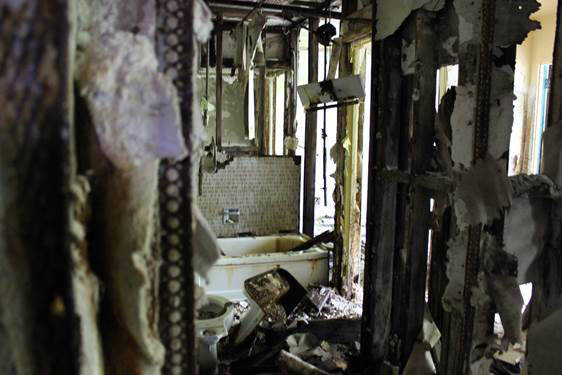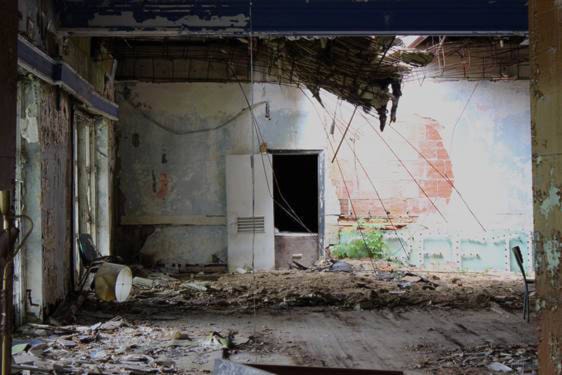By Paul MacDonell
As a child Laura Cuthbert sometimes visited ghost towns with her parents; recently she started seriously documenting her trips.
On Nov. 4, the Cloverdale Library will be home to some of Laura’s ghostly tales. From 1:30 p.m. to 3 p.m., you can listen her tell stories of the historical documentation, environmentalism, preservation and backroads trouble of B.C.’s ghost towns.
I met up with Laura in a coffee shop in New Westminster to chat about her love of abandoned places. She certainly has an eclectic set of interests, coming from a background of museums and archives, but above all Laura is friendly, talkative and passionate about abandoned towns.
She has visited 300 across the Pacific North Coast between B.C. and California in the past eight years, and is also working on an open-source interactive timeline of B.C. ghost towns, with the help of a few developers and many volunteers.
I start off by asking her to define a ghost town. The basic definition is simply a town with no inhabitants. But in reality, especially for bigger towns, this is rarely case.
“There are at least a couple of people around that check in on the town…But it is very low population,” Laura said. “The most I think I have seen in a town is eight.”
When she visits each town, Laura asks herself four questions. Her first question, what is there now, leads naturally to the next: what was there? Were the buildings dismantled? Are there gardens that prove people were there? Laura takes all of these clues and uses them as starting points for her research in museums, archives, interviews or any other place she can get answers.
Her third question looks at the new: who is still there? But Laura feels the last one is the most important: who was there?This is the one she concentrates on most.
Many of us envision these places as settled by white people, who later left. But the reality is often different. Ghost towns in B.C. often had Chinatowns and Japantowns, like Sandon, an abandoned town in the Kootenays.
Sandon was a mining town whose population peaked around 5,000 at the end of the nineteenth century. But in the Second World War, part of the town was also a Japanese internment camp. Laura mentions a disturbing photograph she saw of one of the original land owners sitting in front of the hotel posing with some of the Japanese-Canadians held there.
As our conversation continues, it becomes clear to me that Laura isn’t necessarily interested in visiting places that fit the dictionary definition of a “ghost town.”
It is the people who lived there – all of them – that keeps her interested.
“We tend to know about the colonial founder of the town or about the hotel that was there, but we know less about the families that were there, and less about the Japantowns and the Chinatowns that were there,” she said. She didn’t know, for example, about the Japanese camp in Ocean Falls prior to visiting, but learned a great deal more after she found out.There are also numerous indigenous settlements throughout B.C. which Laura does not define as “ghost towns,” but still interested in the history and stories of those who lived there.
Her “best experiences” of ghost towns happen there still a few people around to talk.
“They usually have really good stories and not just about the start of the town or the end of the town but about how they’ve interacted with it,” she said.
Laura tells me with some glee about a character named Norm who lives next to Ocean Falls, once a large company town on the Central Coast of B.C. Now, the town holds a five-storey hotel, many homes, a co-op building, a tennis court and myriad objects left behind. Norm collects many of these for display in his “museum.” Among the assortment of odd things that he has salvaged — depictions of Garfield. During the 1970s, lots of people collected Garfield cat dolls and Norm has gathered them together for a museum display.
Laura feels the towns are still important because “once you start going to them, you start seeing the same patterns over and over,” she said. And she believes these towns tell us something about urban planning in larger cities in terms of neighbourhood development.
“Looking at the gentrification of Vancouver’s Chinatown right now, it is really hard not to see the other 296 Chinatowns that are already gone,” she said.
And it is surprising how many abandoned towns are in BC: about 170, if you count empty fields, she said. (Some places did have houses that were later removed.)
There seems be very few restrictions on visiting the towns — although she has gotten a few tickets over time — but there are definitely environmental dangers. Many old tailings ponds were often “near the town” and quite close to actual homes. Laura finds out the locations of anything dangerous in advance, and said she won’t do anything stupid, “go into a mining shaft for example.”
I end our conversation with the most important question of all: are there ghosts in ghost towns?
Laura laughs. “It depends on who you ask.”
For those who don’t have much experience but are interested in visiting ghost towns, Laura recommends Coalmont and Granite City in the Similkameen since they are both close by, as well as places like Barkerville.
And of course, you can come to Cloverdale Library on Saturday, Nov. 4 in the afternoon to hear Laura Cuthbert’s talk and slide presentation. It is all free, but we do ask you to register by visiting the library or by calling 604-598-7327.
Information Services Librarian Paul MacDonell writes on the people and events of Cloverdale Library.
- MORE BY MacDONELL: Modern day gladiators: why we’re still interested in sports
- SEE ALSO: Surrey gets spooky for Halloween

